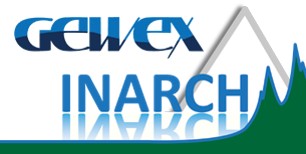Alpine MUltiscale Numerical Distributed Simulation ENgine (openAMUNDSEN)
The open source, physically based Alpine snowcover model openAMUNDSEN (Alpine MUltiscale Numerical
Distributed Simulation ENgine) for the continuous modelling of hydro-climatological
processes provides distributed time series of energy and water mass fluxes for high
mountain regions employing a wide range of interpolation, parameterization, and simulation
procedures. The model is in development and continuous improvement since 2001.
https://github.com/openamundsen/openamundsen#readme and https://github.com/openamundsen/openamundsen
References
Strasser, U., Warscher, M., & Liston, G. E. (2011). Modeling snow–canopy processes on an idealized mountain. Journal of Hydrometeorology, 12(4), 663-677, https://doi.org/10.1175/2011JHM1344.1.
Hanzer, F., Helfricht, K., Marke, T., and Strasser, U.: Multilevel spatiotemporal validation of snow/ice mass balance and runoff modeling in glacierized catchments, The Cryosphere, 10, 1859–1881, https://doi.org/10.5194/tc-10-1859-2016, 2016.
Hanzer, F., Förster, K., Nemec, J. and Strasser, U. (2018): Projected hydrological and cryospheric impacts of 21st century climate change in the Ötztal Alps (Austria) simulated using a physically based approach, Hydrol. Earth Syst. Sci., 22, 1593-1614, https://dx.doi.org/10.5194/hess-22-1593-2018.
Hanzer, F., Carmagnola, C. M., Ebner, P. P., Koch, F., Monti, F., Bavay, M., ... & Morin, S. (2020). Simulation of snow management in Alpine ski resorts using three different snow models. Cold Regions Science and Technology, 172, 102995, https://doi.org/10.1016/j.coldregions.2020.102995.
Canadian Hydrological Model (CHM)
CHM is a multi-scale and multi-resolution hydrological model. It uses a variable resolution mesh to capture fine-scale variability where it exists, while reducing computational demands by reducing resolution in other parts of the domain. It has the design goals of i) multi-scale, multi-physics, variable complexity and domain, ii) assessment of model structural, parameter, and data uncertainty, iii) ability to test multiple hypotheses, avoid rigid model structures, iv) incorporating existing code, and v) contributing to decision support systems. Many existing process algorithms have been ported into CHM, and given its flexibility and robustness, this model represents the next generation in cold regions hydrological modelling with the capability to bridge scales from local to regional to large basin-scale.
https://github.com/Chrismarsh/CHM
References
Marsh, C. B., Pomeroy, J. W., and Wheater, H. S.: The Canadian Hydrological Model (CHM) v1.0: a multi-scale, multi-extent, variable-complexity hydrological model – design and overview, Geosci. Model Dev., 13, 225–247, https://doi.org/10.5194/gmd-13-225-2020, 2020.
Vionnet, V., Marsh, C. B., Menounos, B., Gascoin, S., Wayand, N. E., Shea, J., Mukherjee, K., and Pomeroy, J. W.: Multi-scale snowdrift-permitting modelling of mountain snowpack, The Cryosphere, 15, 743–769, https://doi.org/10.5194/tc-15-743-2021, 2021.
Cold Regions Hydrological Modelling (CRHM) platform
CRHM is a flexible modelling system that can be used to generate a process hydrology model, specific to the needs of the user. A functioning model is built by selecting various process modules from a library based on several decades of hydrological research. CRHM can be applied at point scales and over small to medium sized river basins to simulate system behavior and response to climate and other changes, and is particularly useful for disentangling complex process interactions between climate, vegetation, snow, glaciers, permafrost, land management, surface–atmosphere fluxes, and runoff.
References
Pomeroy, J. W., Brown, T., Fang, X., Shook, K. R., Pradhananga, D., Armstrong, R., ... & Lopez Moreno, J. I. (2022). The Cold Regions Hydrological Modelling Platform for hydrological diagnosis and prediction based on process understanding. Journal of Hydrology, 128711. https://doi.org/10.1016/j.jhydrol.2022.128711
Pomeroy, J. W., Gray, D. M., Brown, T., Hedstrom, N. R., Quinton, W. L., Granger, R. J., & Carey, S. K. (2007). The cold regions hydrological model: a platform for basing process representation and model structure on physical evidence. Hydrological Processes: An International Journal, 21(19), 2650-2667. https://doi.org/10.1002/hyp.6787
Generalized Analog Regression Downscaling (GARD)
This code is an implementation of a hybrid analog / regression multivariate downscaling procedure. While this was developed for downscaling climate data, it is general purpose and could be applied to a wide variety of problems in which both analogs and regression make sense.
Intermediate Complexity Atmospheric Research Model (ICAR)
ICAR is a simplified atmospheric model designed primarily for climate downscaling, atmospheric sensitivity tests, and hopefully educational uses. ICAR combines an analytical solution for flow over mountains (linear mountain wave theory) with the large scale flow for a driving model to predict the high resolution wind field. It then advects and heat and moisture through the domain while computing cloud microphysical effects. ICAR has includes a land surface model as well for land atmosphere interactions; ICAR can simulate open water fluxes, PBL mixing, surface radiation, and even parameterized convection.
References
Gutmann, E. D., I. Barstad, M. P. Clark, J. R. Arnold, and R. M. Rasmussen (2016), The Intermediate Complexity Atmospheric Research Model, J. Hydrometeor, https://doi.org/10.1175/JHM-D-15-0155.1
Modélisation Environmentale Surface and Hydrology (MESH) model
MESH is a stand-alone land-surface–hydrology scheme designed for both forecasting and open loop (i.e., without feedbacks to the atmosphere) simulations. As a hydrology modelling system, MESH captures many of the important land-surface processes necessary for cold-regions simulation. It is a flexible modelling framework that facilitates inter-comparison of alternative algorithms and models (e.g., land surface schemes and routing schemes), and can be applied over vast river basins.
References
Pietroniro, A., Fortin, V., Kouwen, N., Neal, C., Turcotte, R., Davison, B., Verseghy, D., Soulis, E. D., Caldwell, R., Evora, N., and Pellerin, P.: Development of the MESH modelling system for hydrological ensemble forecasting of the Laurentian Great Lakes at the regional scale, Hydrol. Earth Syst. Sci., 11, 1279–1294, https://doi.org/10.5194/hess-11-1279-2007, 2007.
Wheater, H. S., Pomeroy, J. W., Pietroniro, A., Davison, B., Elshamy, M., Yassin, F., ... & Bahrami, A. (2022). Advances in modelling large river basins in cold regions with Modélisation Environmentale Communautaire—Surface and Hydrology (MESH), the Canadian hydrological land surface scheme. Hydrological Processes, 36(4), e14557. https://doi.org/10.1002/hyp.14557.
SnowCast
SnowCast is an experimental data product that uses the Global Environmental Multiscale (GEM) model forecasts from Environment and Climate Change Canada (ECCC) to drive the Canadian Hydrological Model (CHM). Estimates of snowpack are provided over the a Bow River Basin, centered over Banff, Canada.
